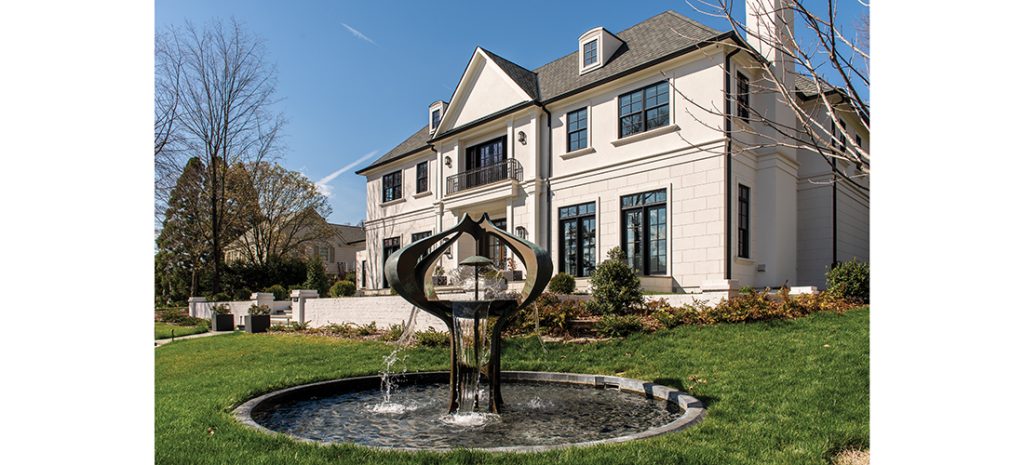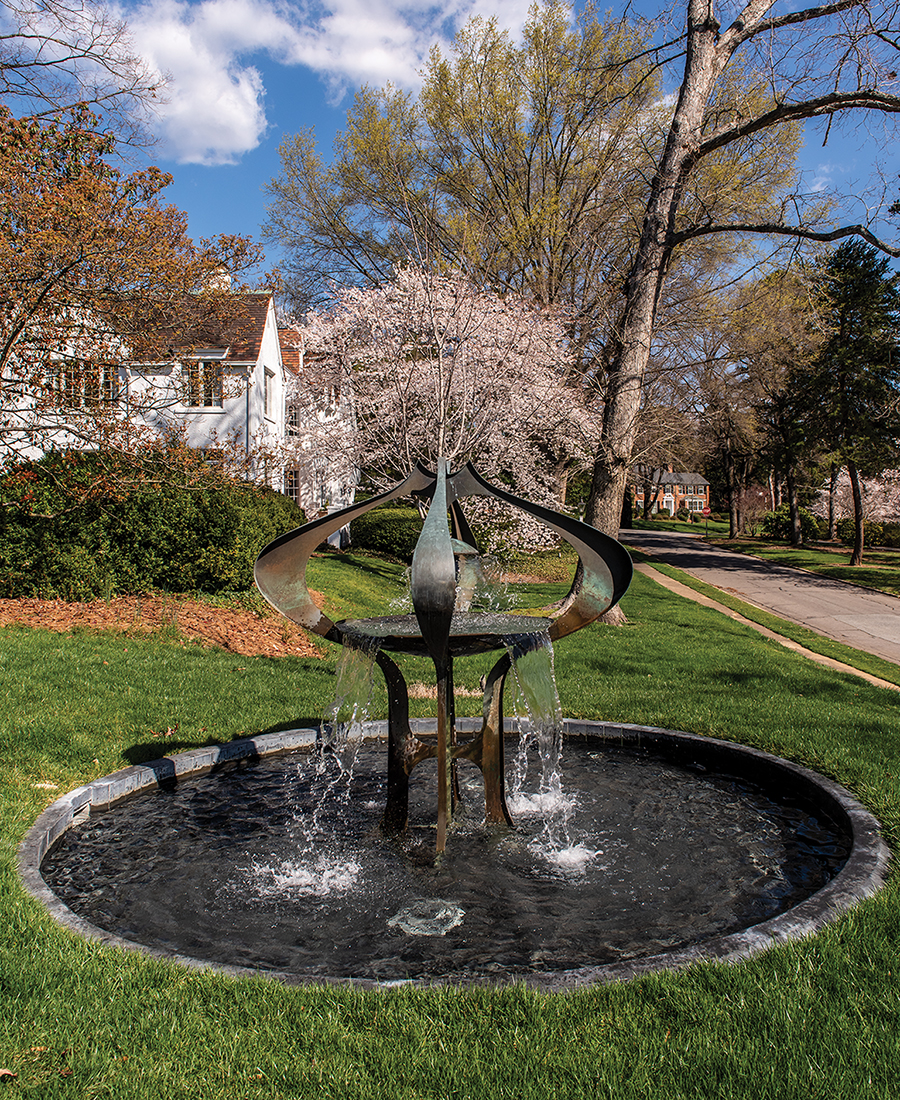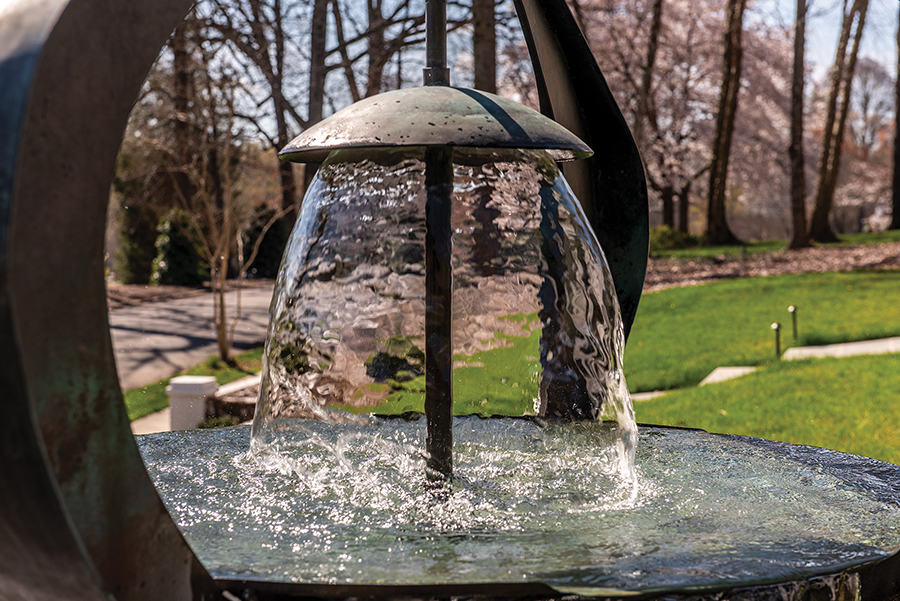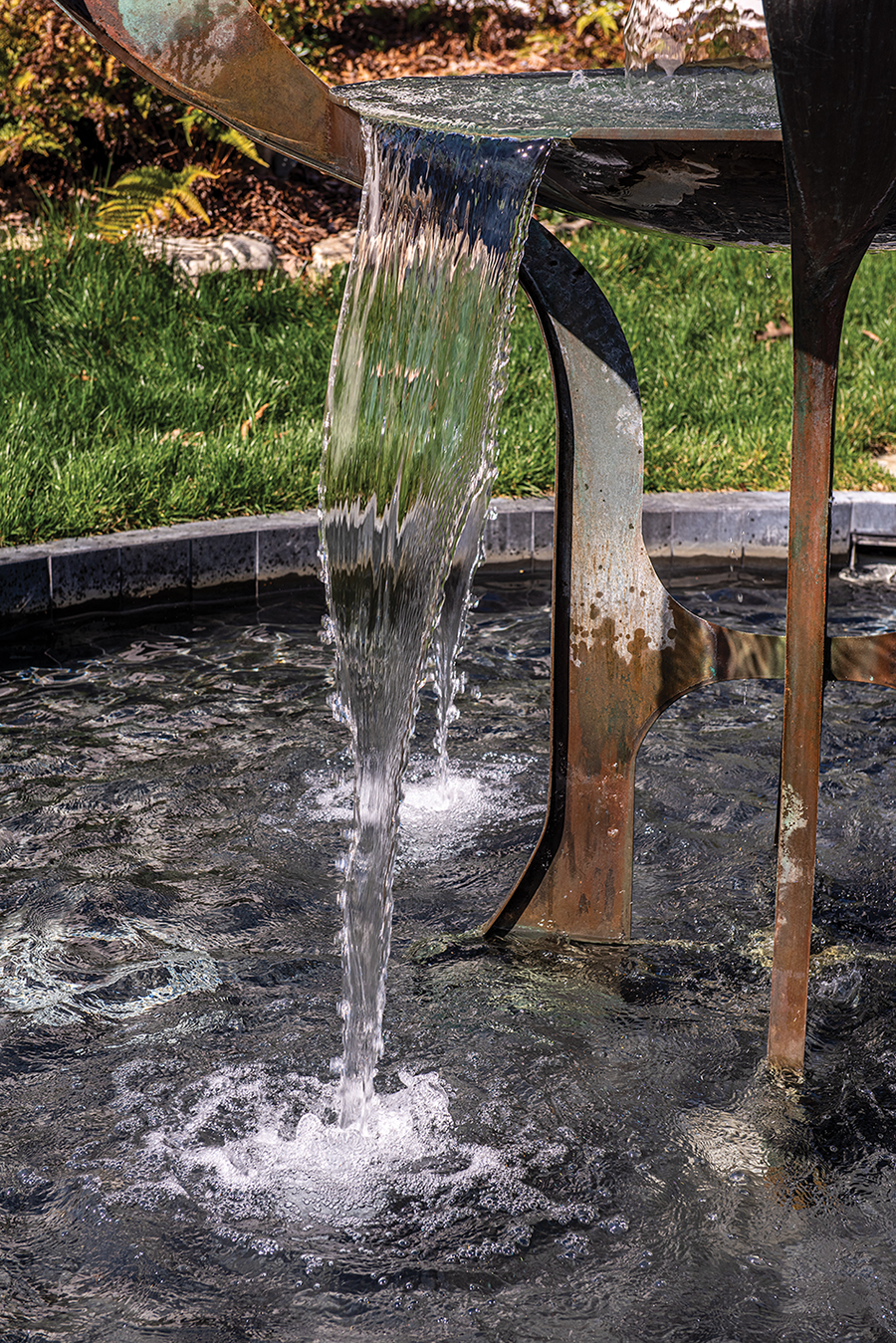A Tale of Two Fountains

By Cynthia Adams
Photographs by Lynn Donovan
For decades, a Paul Billingsley-designed fountain was a centerpiece during the glory days of the sprawling Southcenter Mall near Seattle, Washington. Now, the unique work has been rescued, brought thousands of mile across country to occupy pride-of-place at a new home in Greensboro’s Irving Park.
How — and why — did this happen?

The phone call came early one frigid winter’s morning.
“Hey, go check out this fountain. It’s really neat, and you’ll want to get some pictures while it’s partially frozen,” said lover-of-the-great-outdoors Daniel Craft, who called me with the tip. He dangled a tantalizing tidbit: “There’s a great story that goes along with it.”
Having admired the striking water feature — a lotus flower — that was equal parts bronze sculpture and fountain, Craft was curious about the distinctive fountain. He contacted neighbors Marius and Hilary Andersen to learn more.
He learned the mesmerizing beauty was more than a graceful fountain—it held a mystery at its heart. And its provenance spanned from Seattle to Greensboro — with a story that began 55 years ago.
More than one fountain was intertwined with its history, too, the Andersens explained.
In 1968, a fountain was commissioned from noted Washington state sculptor George Tsutakawa by developers of the Southcenter Mall and was ready for installation. Tsutakawa had designed and built scores of fountains and works of public art; this particular piece was intended for a 1-million-square-foot mall being built in Tukwila, Washington, outside Seattle. He had produced another in 1962 for Northgate Shopping Center, also in Washington.
The Tsutakawa fountain, however, went missing. It was stolen shortly after delivery at the site — before it was installed.
Hilary Andersen’s father, Don Samuelson, a Seattle native, was a young executive with Bon Marché, a primary anchor of the new mall. He remembers the fountain’s disappearance well. (And though he doesn’t have a photo of the original work, he recalls details which were well known to his daughter, Hilary, and her husband, Marius.)
“It was made in bronze, and people steal copper and bronze all the time,” relates Marius. “It could have been hauled off for scrap — who knows?”
That, too, remains a mystery, as the fountain was never recovered.
Tsutakawa was known for sculptures that fused Japanese and American styles. Among a slew of other notable works found throughout America, Canada and Japan, he designed the medals for the 1962 Seattle World’s Fair and the 1976 Spokane Exposition.
The mall developers reached back to Tsutakawa to request a replacement, but his work was in such high demand he was unable to accept another commission. Instead, his student assistant, Paul Billingsley III, also a fine artist, took on the project. The resulting fountain, a graceful lotus flower, was his own design. Naturally, he was influenced by the master artist.
“I think if you look at the lotus flower, you’d be hard pressed to say that it’s not along the lines of other sculptures that Tsutakawa made.” Not a replica of the lost original, explains Marius, but done in the spirit of the original.
Fortunately, the replacement fountain Billingsley created was safely delivered and escaped theft.
“They install it, have an opening and big party in the mall — this was installed inside the mall. Fast forward. It’s part of the mall for many years, until the mid-’90s when they’re remodeling,” says Marius. “By this time, Hilary’s dad has been an exec with Bon Marché, traveling throughout the Pacific Northwest.”
“It was probably 1996,” adds Hilary.
As fate would have it, her father, now a vice president, returned to Washington State’s Tukwila mall where he began his career nearly 30 years earlier. And he brought fond memories of the graceful fountain. He well remembered the fountain’s backstory, which was part of his own experiences, having participated in the opening celebration when the work was first installed at Southcenter.
When Samuelson learned of a scheduled remodel, he asked the mall owners what they were going to do with the fountain. Learning it was slated to be removed, he offered to buy it. His offer was accepted.
For many years, Tsutakawa’s name was renowned in the Northwest, especially the Puget Sound area, and so was Billingsley’s. The initials “TUB” had frequently appeared on Tsutakawa’s installations — “B” for Billingsley.
Billingsley earned a fine arts degree at the University of Washington, and, after a stint in the Army, returned to Seattle and worked for Tsutakawa. According to his obituary, fountains they created were displayed in Seattle, Los Angeles, Honolulu and abroad.
Hilary’s father, Samuelson, called Marius, who then lived nearby, with an S.O.S. “I need you to bring your pickup truck and help me,” he told his son-in-law.
“We took it home to his house,” says Marius. In a vintage photo, he shows the work loaded on the back of a truck.
Samuelson wanted the fountain to be saved and enjoyed. He planned to donate it to the city of Tukwila for a public space or park. As is frequently the case with donated works of public art, there are costs associated with siting a piece, maintaining and also insuring it.


Instead, the fountain landed in Samuelson’s backyard, explains Marius. “He didn’t install it with a pump as a fountain, just as a sculpture.”
At the time, neither Hilary nor her mom were sure about it. But Marius and his father-in-law were true fans.
Fast forward to 2020. The couple, founders of Creative Snacks, had relocated to the Triad.
Once their new North Carolina home was built, Samuelson, knowing how Marius loved the fountain, approached him. “He says, ‘This deserves a home. Would you want it?’” Marius relates.
But now Hilary, who had developed her eye for art, truly admired the work, too. The couple agreed, and made plans for the piece to be shipped from the West Coast to Greensboro in the fall of 2020 as they were completing their home.
“I had to get a crate built for it to be shipped; then ship it and set it up. So, this is the most expensive gift I’ve ever been given,” Marius says and shrugs with a laugh.
But once it arrived, they discovered the fountain was too big for the courtyard outside their bedroom as initially discussed. Plus, nobody would see it there.
Instead, the Andersens decided to place it in the front yard, where it was installed by the summer of 2021. Once up and running, it became an instant showstopper.
Eventually, new pieces of information flowed, too. Billingsley had died in November of 2013, and his family sought information about his works.
“My father-in-law is a Seattle native,” says Marius. “He has a Facebook presence. Paul Billingsley’s son, Peter, posts there, and asks, does anybody knows what happened to this fountain? Hilary’s dad says, ‘Hey, I know exactly what happened!’”
Samuelson tried to learn more about the artist, Paul Billingsley, and his works. Peter told him that at least two other fountains created by his father were purchased and placed in North Carolina — possibly as close by as the Triangle or Wilmington.
He learned of Billingsley’s many talents. In addition to using his creative skills in art, Billingsley contributed to designing molds used in the fabrication of artificial bones for Pacific Research. He designed a double-keel boat, and was a prolific bluegrass musician who built his own instruments. He also designed and built his own home, and converted a VW bug into an electric car, according to his obituary.
The fact that the fountain was going to be hauled away was the part, Marius says, that deeply motivated him. A marvelous artwork might have been lost, destroyed for scrap.
“What’s wrong with people? That’s not going to happen,” he determined.
With the fountain in Greensboro, the couple realized it was originally built for indoor use. Concerned about the cold of winter, Marius went to Tractor Supply and found heaters farmers use to keep livestock watering troughs from freezing. Once in place, the heaters worked to his great satisfaction.
Ultimately, the fountain’s biggest advocate, Samuelson, traveled to Greensboro in May 2022 for a grandchild’s graduation and finally saw the fountain restored to its former glory, fully installed and operational.
“Our neighbors, Kerry and John Ellison, said ‘Thank you for this.’ The fountain reminds them of being in Aspen, given the way the light dances on the leaves. They have coffee on their porch and enjoy the white noise of it,” says Hilary.
When Hilary learned a few people didn’t necessarily like the fountain, she grew protective. “What do you mean? How can you not love it?”
But Marius likes that not everyone agreed. “I love that some think it’s terrible and some love it.” He feels that’s what art does — it stimulates.
The couple mentions other Greensboro homes with avant garde sculptures, something they have come to admire.
“We don’t pretend to be art connoisseurs,” the couple stresses. But their daughter, an artist, is attending the prestigious Rhode Island School of Design this fall.
Meanwhile, the family hopes to visit Billingsley’s other North Carolina-based fountains.
Who knows how many exist in total? When Tsutakawa retired from teaching, he undertook 60 commissions between 1960–69. That time period dovetails with when Billingsley worked beside him as a valued student assistant. An impressive body of work also includes sculptures, gates and fountains. Among others, Tsutakawa created the East Cloister Garth Fountain at the National Cathedral in Washington, D.C.
The likelihood is strong that Paul Billingsley was working alongside as these notable installations were created — and they may even bear the tell-tale “TUB” initials.
In Antique Road Show parlance, check artwork for the all-important signature — even outdoor statuary. They may reveal a surprising history and perhaps an odyssey. OH
